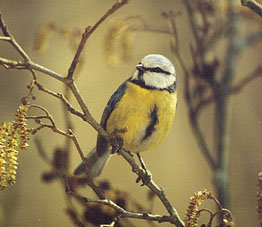|
Back
to Children's Corner
Back to Ireland's Bird Life
Ireland's
Bird Life
A
World of Beauty
Photography
by Richard Mills
Text by Richard Lansdowne
©
Sherkin Island Marine Station
|
|
The
Blue Tit
Parus caeruleus
Meantán gorm
Blue
Tits are a familiar sight in towns and gardens, hanging acrobatically
from the bird table to extract peanuts, or taking the tops
off milk bottles on the doorstep early in the morning. In
the summer, they can be an enormous help to gardners and farmers
as they feed themselves and their young almost exclusively
on caterpillars.
|

|
|
|
|
The
Gannet
Sula bassana
Gainéad
Gannets
nest in huge ancestral colonies on rocky sea cliffs and offshore
islands. Their nests are separated exactly by the distance
which an adult can reach, so that sitting birds and young
are not exposed to the rapier-like thrusts of their neighbours
when on the nest.
|
|
|
|
|
The
Cuckoo
Cuculus canorus
Cuach
Cuckoos
are parasitic upon other birds. The female lays her egg in
the nest of a smaller bird such as a meadow pipit, and as
soon as it hatches, the young cuckoo ejects the eggs of its
host so that there is no competition for food. This photograph
shows a recently fledged young cuckoo, which will soon migrate
south to Africa for the winter.
|
|
|
|
|
Oystercatchers
Haematopus ostralegus
Roilleach
A common
bird of rocky coasts and estuaries, the oystercatcher draws
attention to itself by its loud piping call and striking black
and white plumage with orange bill. This photograph shows
a flock in late winter. Some birds have already moulted into
summer plumage, losing the black tip to the bill and the white
neck band.
|
|
|
|
|
The
Pheasant
Phasianus colchicus
Piasún
Like
various other game birds, pheasants were introduced into Ireland.
However the natural habitat of the pheasant is in the bamboo
and forest-covered hills of China. Hen pheasants are much
less striking than their mates which helps them to avoid detection
by predators when they are sitting on the nest or have small
young.
|
|
|
|
|
The
Wren
Troglodytes troglodytes
Dreoilín
Wrens
are one of the most abundant and widespread birds in Ireland,
occurring from urban gardens, to the wildest sea cliffs and
high mountains. In spite of its small size, the wren has a
loud ringing song which can be heard throughout the year,
even in the wildest winter.
|
|
|
|
|
The
Curlew
Numenius
arquata
Crotach
Curlews
are the commonest of the large waders to occur on our coasts.
In summer, they breed on moors and upland pasture, where their
haunting, bubbling song is a frequent sound in spring and
early summer. (The two smaller birds in the foreground are
redshank.)
|
|
|
© Sherkin Island Marine
Station 2006
|